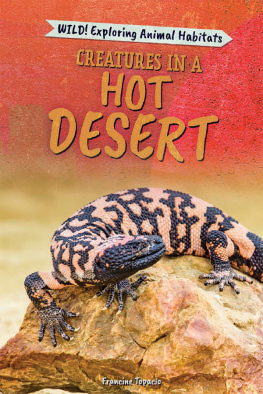Published in 2020 by The Rosen Publishing Group, Inc.
29 East 21st Street, New York, NY 10010
Copyright 2020 by The Rosen Publishing Group, Inc.
All rights reserved. No part of this book may be reproduced in any form without permission in writing from the publisher, except by a reviewer.
Copyright 2011; revised edition 2020
Editor: Elizabeth Krajnik
Book Design: Reann Nye
Photo Credits: Cover Johner Images/Getty Images; Series Art LemonyPo/ Shutterstock.com; p. 5 IrinaK/Shutterstock.com; p. 6 HamsterMan/Shutterstock.com; p. 7 Hendrasu/Shutterstock.com; p. 8 Matthew L Niemiller/Shutterstock.com; p. 9 JURE MAKOVEC/AFP/Getty Images; p. 10 Vladimir Wrangel/Shutterstock. com; p. 11 Jennifer Idol/Stocktrek Images/Getty Images; p. 12 Braden Powell/ Shutterstock.com; p. 13 Jason Patrick Ross/Shutterstock.com; p. 15 Tukkatar/ Shutterstock.com; p. 16 Ivan Kuzmin/Shutterstock.com; p. 17 Alexander Pink/ Shutterstock.com; p. 19 Radius Images/Getty Images Plus/Getty Images; p. 20 Carsten Peter/National Geographic Image Collection/Getty Images; p. 21 Stephane Bidouze/Shutterstock.com; p. 22 Christian Reinwald/Shutterstock.com.
Library of Congress Cataloging-in-Publication Data
Names: Topacio, Francine, author.
Title: Creatures in a dark cave / Francine Topacio.
Description: New York : PowerKids Press, [2020] | Series: Wild! Exploring animal habitats | Includes index.
Identifiers: LCCN 2019003015| ISBN 9781725304291 (paperback) | ISBN 9781725304284 (library bound) | ISBN 9781725304307 (6 pack)
Subjects: LCSH: Cave animals--Juvenile literature. | Habitat (Ecology)--Juvenile literature.
Classification: LCC QL117 .T67 2020 | DDC 591.75/84--dc23
LC record available at https://lccn.loc.gov/2019003015
Manufactured in the United States of America
CPSIA Compliance Information: Batch #CSPK19. For Further Information contact Rosen Publishing, New York, New York at 1-800-237-9932.
CAVE BASICS
Caves are large, hollow places formed by natural processes in the side of a hill or cliff, or underground. These dark places are home to life and rock forms many people have never had the chance to see. Because the suns rays cant reach very far inside caves, theyre usually cool inside. Caves can also be formed from ice.
While some caves are big, others are somewhat small. To be considered a cave, the opening must be large enough for a person to fit inside. Caves may have rooms the size of several football fields or thousands of miles (km) of tunnels.
Creature Corner
Jaguar bones have been found inside Lookout Mountain Cave in Chattanooga, Tennessee. Bones from deer, fox, salamanders, and woodchucks have also been found inside the cave.

Ruby Falls inside Lookout Mountain Cave is the tallest and deepest underground waterfall people can visit in the United States.
CAVE DWELLING
Several different species, or kinds, of animals dwell, or live, in caves. These animals have adapted, or changed, to live better in cave habitats, which are often dark, cold, and wet.
Creature Corner
Some animals are endemic to underground habitats, such as those found in caves. These animals are called troglobionts, or troglobites, which means cave dwelling.

MEXICAN BLIND CAVEFISH

Bats belong to a group of cave dwellers called trogloxenes, subtroglophiles, or cave guests. They live in caves more of the time than cave visitors, but must go outside to find food.
Some cave-dwelling animals live near a caves opening where theres light and warmth from the sun. Others live deep inside the cave, where theres no light. Some of these animals live under rocks on the cave floor or hide in cracks, or small openings, in the cave walls. Some, such as bats, hang from the ceiling. Others live in streams that run through caves.
TROGLOBITES
Many plants and animals need sunlight to survive. However, troglobites, which are creatures born inside and never leave caves, dont need the sun to live. In fact, troglobites wouldnt be able to survive on the surface of Earth. Small troglobites include bugs, spiders, and flatworms, while larger troglobites include cavefish and salamanders.
Creature Corner
Scientists have discovered more than 7,700 species of troglobites. However, there are probably many more to discover because many caves have never been explored.

PRICKLY CAVE CRAYFISH

The olm is a type of cave-dwelling salamander endemic to caves in Slovenia and Croatia. This creature can live to be more than 100 years old. When it was discovered in the 1600s, some people said it looked like a baby dragon.
Because caves are dark, troglobites are usually blind and have eyes that havent grown properly. Many troglobites are pale or white. This is because, without sunlight, theres no need for them to be colored. Troglobites may also have thin skin, longer body parts, and hightened senses.
THE MEXICAN BLIND CAVEFISH
The Mexican blind cavefish, also known as the Mexican tetra, is a species of blind cavefish that lives in underground streams.They are only about 4 inches (10 cm) long.
Food in caves is hard to come by, and the Mexican blind cavefish eats almost anything it can find. It finds food by sensing small vibrations from its prey, which are animals it hunts for food.

Mexican blind cavefish are born with eyes, but as they grow up, their eyes disappear and the place where their eyes used to be becomes covered with fat and scales.
Because the Mexican blind cavefish is sightless, it finds its way around by following the walls of the cave. These fish have special body parts called neuromasts that help them sense where the wall is and how far away from it they are.
TROGLOPHILES
Troglophiles are cave lovers. These animals spend all or part of their lives in a cave. However, troglophiles are different from troglobites because they have no adaptations to survive living in caves all their lives. Small troglophiles include beetles, crickets, spiders, and snails. Some frogs and salamanders are also troglophiles.




















